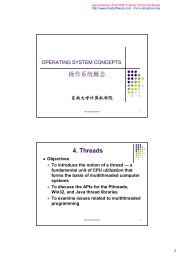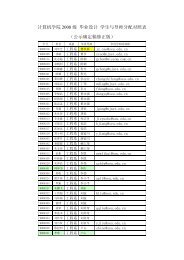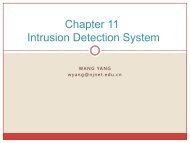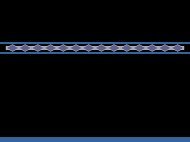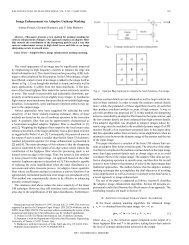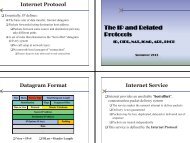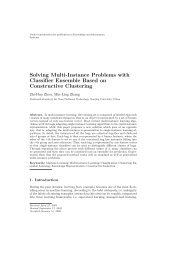will bind strongly to a target protein known to be involved in some disease state. Typically,one has examples of molecules that bind well to the target protein and also of molecules thatdo not bind well. Much as in a lock and key, shape is the most important factor in determiningwhether a drug molecule and the target protein will bind. However, drug molecules areflexible, so they can adopt a wide range of shapes. A positive example does not convey whatshape the molecule took in order to bind – only that one of the shapes that the molecule cantake was the right one. However, a negative example means that none of the shapes that themolecule can achieve was the right key.The multiple-instance learning model was only recently <strong>for</strong>malized by [Dietterich et al., 1997].They assume a hypothesis class of axis-parallel rectangles, and develop algorithms <strong>for</strong> dealingwith the drug activity prediction problem described above. This work was followed by [Longand Tan, 1996], where a high-degree polynomial PAC bound was given <strong>for</strong> the number ofexamples needed to learn in the multiple-instance learning model. [Auer, 1997] gives a moreefficient algorithm, and [Blum and Kalai, 1998] shows that learning from multiple-instanceexamples is reducible to PAC-learning with two sided noise and to the Statistical Query model.Un<strong>for</strong>tunately, the last three papers make the restrictive assumption that all instances from allbags are generated independently.In this paper, we describe a framework called Diverse Density <strong>for</strong> solving multiple-instanceproblems. Diverse Density is a measure of the intersection of the positive bags minus the unionof the negative bags. By maximizing Diverse Density we can find the point of intersection(the desired concept), and also the set of feature weights that lead to the best intersection.We show results of applying this algorithm to a difficult synthetic training set as well as the“musk” data set from [Dietterich et al., 1997]. We then use Diverse Density in two novelapplications: one is to learn a simple description of a person from a series of images that arelabeled positive if the person is somewhere in the image and negative otherwise. The other isto deal with a high amount of noise in a stock selection problem.2 Diverse DensityWe motivate the idea of Diverse Density through a molecular example. Suppose that theshape of a candidate molecule can be adequately described by a feature vector . One instanceof the molecule is there<strong>for</strong>e represented as a point in n-dimensional feature space. As themolecule changes its shape (through both rigid and non-rigid trans<strong>for</strong>mations), it will trace outa manifold through this n-dimensional space 1 . Figure 1(a) shows the paths of four moleculesthrough a 2-dimensional feature space.If a candidate molecule is labeled positive, we know that in at least one place along themanifold, it took on the right shape <strong>for</strong> it to fit into the target protein. If the molecule is labelednegative, we know that none of the con<strong>for</strong>mations along its manifold will allow binding withthe target protein. If we assume that there is only one shape that will bind to the target protein,what do the positive and negative manifolds tell us about the location of the correct shapein feature space? The answer: it is where all positive feature-manifolds intersect withoutintersecting any negative feature-manifolds. For example, in Figure 1(a) it is point A.Un<strong>for</strong>tunately, a multiple-instance bag does not give us complete distribution in<strong>for</strong>mation,but only some arbitrary sample from that distribution. In fact, in applications other thandrug discovery, there is not even a notion of an underlying continuous manifold. There<strong>for</strong>e,1 In practice, one needs to restrict consideration to shapes of the molecule that have sufficiently lowpotential energy. But, we ignore this restriction in this simple illustration.
positivebag #1negative bagpositivebag #1negative bagpositivebag #2point Apositivebag #2point AsectionB {positivebag #3(a)The different shapes that a molecule cantake on are represented as a path. The intersectionpoint of positive paths is where theytook on the same shape.positivebag #3(b)Samples taken along the paths. Section Bis a high density area, but point A is a highDiverse Density area.Figure 1: A motivating example <strong>for</strong> Diverse DensityFigure 1(a) becomes Figure 1(b). The problem of trying to find an intersection changesto a problem of trying to find an area where there is both high density of positive pointsand low density of negative points. The difficulty with using regular density is illustrated inFigure 1(b), Section B. We are not just looking <strong>for</strong> high density, but high “Diverse Density”.We define Diverse Density at a point to be a measure of how many different positive bags haveinstances near that point, and how far the negative instances are from that point.2.1 Algorithms <strong>for</strong> multiple-instance learningIn this section, we derive a probabilistic measure of Diverse Density, and test it on a difficultartificial data set. We denote positive bags as B + i , the jth point in that bag as B + ij, and thevalue of the k th feature of that point as B + ijk . Likewise, B; ijrepresents a negative point.Assuming <strong>for</strong> now that the true concept is a single point t, we can find it by maximizingPr(x = t j B + 1 B+ n B; 1 B; m ) over all points x in feature space. If we use Bayes’rule and an unin<strong>for</strong>mative prior over the concept location, this is equivalent to maximizingthe likelihood Pr(B + 1 B+ n B; 1 B; m j x = t). By making the additional assumptionthat the bags are conditionally independent given the target concept t, the best hypothesis isarg max xQi Q Pr(B+ i j x = t) i Pr(B; i j x = t). Using Bayes’ rule once more (and againassuming a uni<strong>for</strong>m prior over concept location), this is equivalent toYarg max Pr(x = t j B + Yxi ) Pr(x = t j B ; i ): (1)iThis is a general definition of maximum Diverse Density, but we need to define the terms in theproducts to instantiate it. One possibilityis a noisy-or model: the probability that not all pointsmissed the target is Pr(x = t j B + i )=Pr(x = t j B+ i1 B+ :::)=1;Q i2 j (1;Pr(x = tjB+ ij )),and likewise Pr(x = t j B ; )=Q i j (1 ; Pr(x = t j B; ij )). We model the causal probability ofan individual instance on a potential target as related to the distance between them. Namely,Pr(x = t j B ij )=exp(; kB ij ; x k 2 ). Intuitively, if one of the instances in a positive bagis close to x, then Pr(x = t j B + i ) is high. Likewise, if every positive bag has an instanceclose to x and no negative bags are close to x, then x will have high Diverse Density. DiverseDensity at an intersection of n bags is exponentially higher than it is at an intersection of n ; 1bags, yet all it takes is one well placed negative instance to drive the Diverse Density down.i




